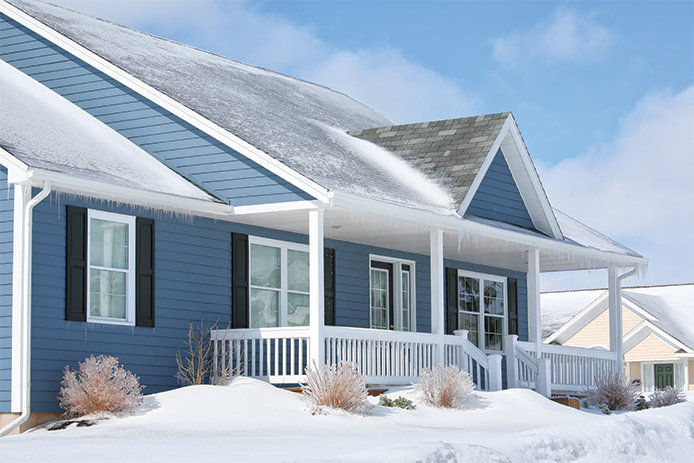How to Get Your Home Ready for Winter

The days of winter coats, seeing your breath in the air, and freezing temperatures are quickly approaching. With the first frost just around the corner, it’s time to start winterizing your home to help protect it against the harsh winter weather. We all know there’s nothing better than the comforts of your cozy, warm house on a cold day. This season, get ahead of the cold weather and ensure your home stays warm all winter long with these tips to get your home ready for winter.
Seal Leaks, Cracks & Gaps
Cold drafts come from more than just your windows and doors. Attics, air ducts, chimneys, and even the kitchen hood vent can be entry points for cold air.
- Install weather stripping or a door sweep to exterior doors to seal any drafty door.
- Caulk cracks or gaps around your windows, chimney, air ducts, and attic to halt the cold air flow to the inside of your home. If you have a bigger area that needs filled, try an expanding foam sealant instead.
- Shut the fireplace damper when the fireplace is not in use. An open damper can result in heat loss and draftiness throughout your house.
- Make sure the attic, especially the attic ceiling, is well insulated. Insulation keeps the warm inside during winter months and cool air inside during warmer months.
- Inspect your foundation for small cracks or openings where mice and pests can get in when they’re seeking warmth.
- Have your furnace and exposed air ducts inspected by an HVAC professional to ensure your unit is running efficiently with no leaks or holes. They can be sealed with a foil or mastic tape.
Get on Top of Roof Problems
- Install de-icing cables near gutters, downspouts, and shingles to prevent water damage from ice dams, especially in areas that are prone to winter storms and heavy snowfall.
- Make sure gutters and downspouts are all secure, as the weight of snow and ice can pull them off the house if they’re not secured well enough.
- Clean gutters of any debris and make sure downspouts are at least 5 feet away from your house to prevent flooding or water damage from snowmelt.
- Cover all vents to keep insects, birds, and pests out.
- Have your roof inspected for any damaged or warped shingles and have them replaced before you have a leak.
Use a Programmable Thermostat
Programmable thermostats keep temperatures consistent and saves you fuel. Set your thermostat to automatically lower temperature when you’re sleeping or when you’re away for long periods of time. If you’re chilly, add more layers of clothes instead of turning up the heat.
Call in an Arborist

Have a professional identify any rotting trees, dead, or dangling limbs that may come down in a storm. Icy conditions can cause branches to break, fall, and damage your home or your power lines.
Use Window Coverings

During the day, open south facing curtains to let sun and warmth in and close the curtains to conserve heat at night. Closing the curtains prevents warmth from escaping. Sunlight equals free heat, capture it as much as possible!
Buy a Rug or Two
Uninsulated floors, like tile and wood, can be cold and can be the main reason for heat loss in your home. Lay area rugs and runners to trap heat and make your home feel much cozier. You can also break out the blankets, wool socks, hot coco, big comforters, and hoodies!
Don’t Heat Unused Rooms

Why heat rooms that you don’t use?
- Shut the vent or use a vent cover, and close the doors for rooms you don’t use. The warmer air will spread quicker and easier to rooms you do use.
- Keep the door closed in rooms that are heated, so that the warm air stays in the room (almost like a sauna).
- Space heaters are a great tool for keeping individual rooms warm. They can be a fire hazard, so check these fire safety tips to learn more about space heater safety.
Be Prepared for an Emergency
A winter storm could leave you snowed in or without power. Having the following items will make sure you’re prepared in case of a winter emergency. You'll want to have nonperishable food items stocked, the numbers of your utility companies, batteries, first aid kits, and maybe even a portable generator.
Protecting your home in winter conditions is vital. By following these steps, you’ll be ready even for winter’s worst. This winter stay warm and enjoy the financial benefits of preparing your house for winter. Stop by your local Do it Best hardware store for winter essentials, or shop online at doitbest.com.
While do-it-yourself projects can be fun and fulfilling, there is always a potential for personal injury or property damage. We strongly suggest that any project beyond your abilities be left to licensed professionals such as electricians, plumbers, and carpenters. Any action you take upon the information on this website is strictly at your own risk, and we assume no responsibility or liability for the contents of this article.